
Ob5 Cloxacillin
Login to see pricesBrand:
Thermo ScientificTM OxoidTM

Da10 Clindamycin
Login to see pricesBrand:
Thermo ScientificTM OxoidTM

C50 Chloramphenicol
Login to see pricesBrand:
Thermo ScientificTM OxoidTM

C30 Chloramphenicol
Login to see pricesBrand:
Thermo ScientificTM OxoidTM

C10 Chloramphenicol
Login to see pricesBrand:
Thermo ScientificTM OxoidTM

Kz30 Cephazolin
Login to see pricesBrand:
Thermo ScientificTM OxoidTM

Kf30 Cephalothin
Login to see pricesBrand:
Thermo ScientificTM OxoidTM
Manually determine the antibiotic susceptibility of microorganisms using Antimicrobial Susceptibility Testing (AST) methods in conjunction with reliable, easy-to-use Thermo Scientific™ Oxoid™ Cephalothin Antimicrobial Susceptibility Disks.

Cl30 Cephalexin
Login to see pricesBrand:
Thermo ScientificTM OxoidTM
Manually determine the antibiotic susceptibility of microorganisms using Antimicrobial Susceptibility Testing (AST) methods in conjunction with reliable, easy-to-use Thermo Scientific™ Oxoid™ Cephalexin Antimicrobial Susceptibility Disks.

B10 Bacitracin
Login to see pricesBrand:
Thermo ScientificTM OxoidTM

Amp25 Ampicillin
Login to see pricesBrand:
Thermo ScientificTM OxoidTM
** This item is not available at the moment. Please contact us for more information.
Manually determine the antibiotic susceptibility of microorganisms using Antimicrobial Susceptibility Testing (AST) methods in conjunction with reliable, easy-to-use Thermo Scientific™ Oxoid™ Ampicillin Antimicrobial Susceptibility Disks.

Amp10 Ampicillin
Login to see pricesBrand:
Thermo ScientificTM OxoidTM
Manually determine the antibiotic susceptibility of microorganisms using Antimicrobial Susceptibility Testing (AST) methods in conjunction with reliable, easy-to-use Thermo Scientific™ Oxoid™ Ampicillin Antimicrobial Susceptibility Disks.

Amp2 Ampicillin
Login to see pricesBrand:
Thermo ScientificTM OxoidTM

CampyGen 3.5L (10/Pack)
Login to see pricesBrand:
Thermo ScientificTM OxoidTM
Produce suitable gaseous atmosphere for growth of microaerophilic microorganisms with the Oxoid CampyGen 3.5L Sachet.
- No water or catalyst required
- No hydrogen gas produced
- For use with Thermo Scientific Oxoid 3.5L Anaerobic Jar, Part No. HP0011A, HP0031A
Precautions
This product is for in vitro use only
As soon as the CampyGen paper sachet is exposed to air, the reaction will start. It is therefore essential that the paper sachet is placed in the jar and the jar sealed within one minute.
The reaction of the ascorbic acid with oxygen is exothermic. However, the temperature of the CampyGen paper sachet will not exceed 65°C.
Storage
Store at 2-25°C. Under these conditions, the CampyGen sachets will retain their reactivity until the expiry date given on the outer box and on the foil sachet.

CampyGen 2.5L (10 pack)
Login to see pricesBrand:
Thermo ScientificTM OxoidTM
- Produce suitable gaseous atmosphere for growth of microaerophilic microorganisms with Oxoid CampyGen 2.5L Sachet.
- No water or catalyst required.
- No hydrogen gas produced.
- For AnaeroJar™ 2.5L, Part No. AG0025A.
Precautions
This product is for in vitro use only
As soon as the CampyGen paper sachet is exposed to air, the reaction will start. It is therefore essential that the paper sachet is placed in the jar and the jar sealed within one minute.
The reaction of the ascorbic acid with oxygen is exothermic. However, the temperature of the CampyGen paper sachet will not exceed 65°C.
Storage
Store at 2-25°C. Under these conditions, the CampyGen sachets will retain their reactivity until the expiry date given on the outer box and on the foil sachet.
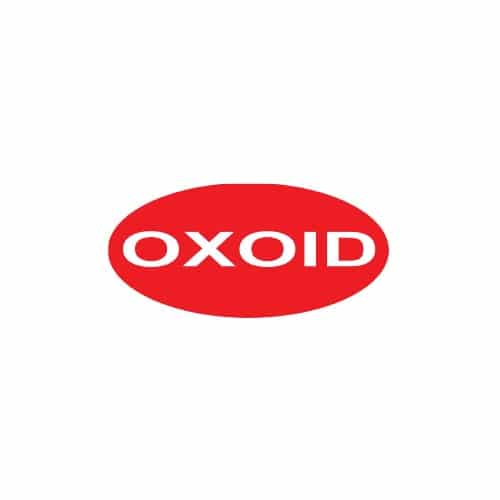
CampyGen Compact 20/Pck
Login to see pricesBrand:
Thermo ScientificTM OxoidTM
- Produce suitable gaseous atmosphere for growth of microaerophilic microorganisms with the Oxoid CampyGen Compact Sachet.
- For use in Compact Plastic Pouch.
- Each pouch holds 2 standard size petri dishes.
- No water or catalyst required.
- No hydrogen gas produced.
- Use with Compact Plastic Pouch Part No. AG0020C and AnaeroGen™ Compact Sealing Clip, Part No. AN0005C.
Precautions
This product is for in vitro use only
As soon as the CampyGen paper sachet is exposed to air, the reaction will start. It is therefore essential that the paper sachet is placed in the jar and the jar sealed within one minute.
The reaction of the ascorbic acid with oxygen is exothermic. However, the temperature of the CampyGen paper sachet will not exceed 65°C.
Storage
Store at 2-25°C. Under these conditions, the CampyGen sachets will retain their reactivity until the expiry date given on the outer box and on the foil sachet.
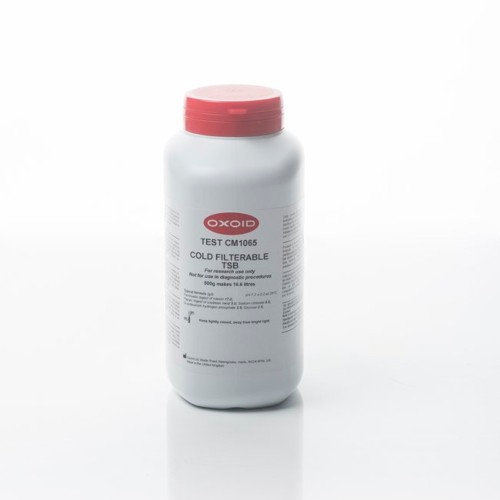
MRS (ISO) Agar 500g
Login to see pricesBrand:
Thermo ScientificTM OxoidTM
Isolate and enumerate lactic acid bacteria from food with Thermo Scientific™ Oxoid™ MRS (ISO) Agar (DeMan, Rogosa and Sharpe) (Dehydrated) while adhering to ISO 15214: 1998. This medium is designed to support the growth of all strains of Lactobacilli, even the difficult and slow-growing strains of Lactobacillus brevis and Lactobacillus fermenti.
MRS (ISO) Agar (DeMan, Rogosa and Sharpe), Oxoid Composition
| Typical Formula * |
gm/litre
|
| Enzymatic digest of casein |
10 |
| Meat extract |
10 |
| Yeast extract |
4 |
| Tri-ammonium citrate |
2 |
| Sodium acetate |
5 |
| Magnesium sulphate heptahydrate |
0.2 |
| Manganese sulphate tetrahydrate |
0.05 |
| Di-potassium hydrogen phosphate |
2 |
| Sorbitan mono-oleate |
1.08 |
| Glucose |
20 |
| Agar |
12.4 |
| TOTAL | 66.73g/L |
MRS (ISO) Agar (DeMan, Rogosa and Sharpe), Oxoid Preparation:
Suspend 66.73g in 1 litre of distilled water. Boil to dissolve the medium completely. Dispense into tubes, bottles or flasks and sterilize by autoclaving at 121°C for 15 minutes. Selectivity can be altered by pH adjustment.
Storage conditions and Shelf life
Store the dehydrated medium at 10–30°C and use before the expiry date on the label.
Store the prepared plates at 2–8°C.
Precautions
Sterilization of this medium in some autoclaves, at 121°C for 15 minutes, may cause the medium in some cases to fall outside the specified pH limit of 5.7 ± 0.1. Adjustment of the medium in these rare cases is recommended using acetic acid or sodium hydroxide.

Pre-Supplemented DG18 (ISO) Agar
Login to see pricesBrand:
Thermo ScientificTM OxoidTM
Isolate and enumerate yeasts and molds associated with food spoilage with Thermo Scientific™ Oxoid™ Pre-supplemented Dichloran-Glycerol 18% (DG18) (ISO) Agar Base (Dehydrated) while adhering to BS ISO 21527-2: 2008. Due to the presence of antibiotic Chloramphenicol in the formulation, the medium provides selectivity against bacteria as well as reducing harmful chemical handling in the laboratory.
Pre-supplemented Dichloran-Glycerol 18% (DG18) (ISO) Agar Base (Dehydrated), Oxoid Composition
| Typical Formula* |
gm/litre |
| Casein Enzymatic digest |
5.0 |
| Glucose |
10.0 |
| Potassium dihydrogen phosphate |
1.0 |
| Magnesium sulphate |
0.5 |
| Dichloran (2,6-dichloro-4-nitroaniline) |
0.002 |
| Agar |
15 |
| Chloramphenicol | 0.1 |
| pH 5.6 ± 0.2 @ 25°C |
Pre-supplemented Dichloran-Glycerol 18% (DG18) (ISO) Agar Base, Oxoid Preparation:
Suspend 15.8g per 500ml (31.6g/l) of distilled water and heat to dissolve completely. Before autoclaving add 220g of Glycerol per 1 litre of medium. Heat the complete solution gently to aid its dissolution of the glycerol. This has been found to be a key procedure to follow to allow proper dissolution of the glycerol. Sterilize by autoclaving at 121°C for 15 minutes. Cool to 50°C, mix well and pour into sterile Petri dishes.
Where bacterial overgrowth occurs from certain foods (raw meats) chlortetracycline hydrochloride at 50mg/L (dissolved in water and filter sterilised) is recommended.
Storage instructions
Store the dehydrated medium at 10–30°C and use before the expiry date.
Precautions
The dichloran compound used in this medium is Botran® 2,6-Dichloro-4-Nitro-Analine (CAS: 99-30-9).
Pre-supplemented DG18 (ISO) Agar (CM1151) contains Chloramphenicol in the base powder and is therefore considered a toxic compound which should be handled in accordance with good industrial hygiene and safety practice. Always consult the MSDS before handling the powder.

Pre-Supplemented DRBC (ISO) Agar
Login to see pricesBrand:
Thermo ScientificTM OxoidTM
Isolate and enumerate yeasts and molds associated with food spoilage with Thermo Scientific™ Oxoid™ Pre-supplemented Dichloran Rose-Bengal Chloramphenicol (DRBC) (ISO) Agar Base (Dehydrated) while adhering to ISO 21527-1: 2008. Due to the presence of antibiotic Chloramphenicol in the formulation, the medium provides selectivity against bacteria as well as reducing harmful chemical handling in the laboratory.
Pre-supplemented Dichloran Rose-Bengal Chloramphenicol (DRBC) (ISO) Agar Base (Dehydrated), Oxoid Composition
| Typical Formula* |
gm/litre |
| Peptone |
5.0 |
| Glucose |
10.0 |
| Potassium dihydrogen phosphate |
1.0 |
| Magnesium sulphate |
0.5 |
| Dichloran |
0.002 |
| Rose-bengal |
0.025 |
| Agar |
15.0 |
| Chloramphenicol |
0.1 |
| pH 5.6 ± 0.2 @ 25°C |
Pre-supplemented Dichloran Rose-Bengal Chloramphenicol (DRBC) (ISO) Agar, Oxoid Preparation:
Suspend 15.75g per 500ml (31.5g/l) of distilled water and heat to dissolve completely. Sterilize by autoclaving at 121°C for 15 minutes. Cool to 50°C, mix well and pour into sterile Petri dishes. It is advised to dispense the powdered medium into containers under an extraction hood due to the chloramphenicol in the medium base.
Storage instructions
Store the dehydrated medium at 10–30°C and use before the expiry date
Precautions
ROSE-BENGAL PHOTO-OXIDIZES TO FORM TOXIC COMPOUNDS. STORE PLATES OF THE MEDIUM IN THE DARK AND AVOID EXPOSURE TO LIGHT.
Some strains of fungi may be inhibited on this medium.
The dichloran compound used in this medium is Botran® 2,6-Dichloro-4-Nitro-Analine (CAS: 99-30-9).
Pre-supplemented DRBC (ISO) Agar (CM1149) contains Chloramphenicol in the base powder and is therefore considered a toxic compound which should be handled in accordance with good industrial hygiene and safety practice. Always consult the MSDS before handling the powder.
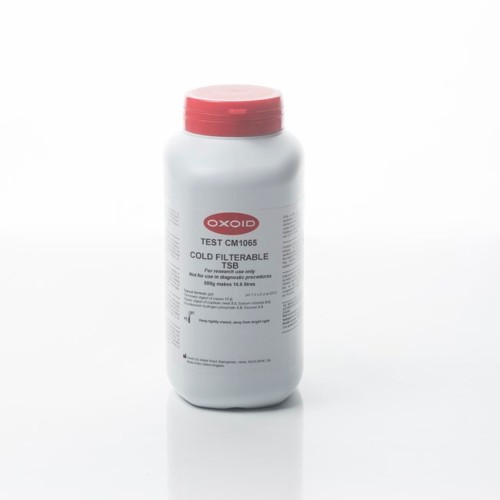
DRBC (ISO) Agar Base 500g
Login to see pricesBrand:
Thermo ScientificTM OxoidTM
Isolate and enumerate yeasts and molds associated with food spoilage with Thermo Scientific™ Oxoid™ Dichloran Rose-Bengal Chloramphenicol (DRBC) (ISO) Agar Base while adhering to ISO 21527-1: 2008. Dichloran Rose-Bengal Chloramphenicol (DRBC) (ISO) Agar is specially designed to suppress the growth of spreading mold and bacteria while supporting the growth of species that cannot be isolated on Rose Bengal Chloramphenicol Agar or Acidified Potato Dextrose Agar.
Dichloran Rose-Bengal Chloramphenicol (DRBC) (ISO) Agar, Oxoid Composition
| Typical Formula* | gm/litre |
| Peptone | 5.0 |
| Glucose | 10.0 |
| Potassium dihydrogen phosphate | 1.0 |
| Magnesium sulphate | 0.5 |
| Dichloran | 0.002 |
| Rose-bengal | 0.025 |
| Agar | 15.0 |
| pH 5.6 ± 0.2 @ 25°C |
Dichloran Rose-Bengal Chloramphenicol (DRBC) (ISO) Agar, Oxoid Preparation:
Suspend 15.75g per 500ml (31.5g/l) of distilled water and heat to dissolve completely. Reconstitute Chloramphenicol Supplement (one vial SR0078E per 500ml or one vial SR0078H per 2 litres medium), as directed. Add the vial contents to the DRBC (ISO) Agar Base. Sterilize by autoclaving at 121°C for 15 minutes. Cool to 50°C, mix well and pour into sterile Petri dishes.
Storage conditions and Shelf life
Store the dehydrated medium at 10–30°C and use before the expiry date.
Precautions
ROSE-BENGAL PHOTO-OXIDIZES TO FORM TOXIC COMPOUNDS. STORE PLATES OF THE MEDIUM IN THE DARK AND AVOID EXPOSURE TO LIGHT.
Some strains of fungi may be inhibited on this medium.
The dichloran compound used in this medium is Botran® 2,6-Dichloro-4-Nitro-Analine (CAS: 99-30-9).
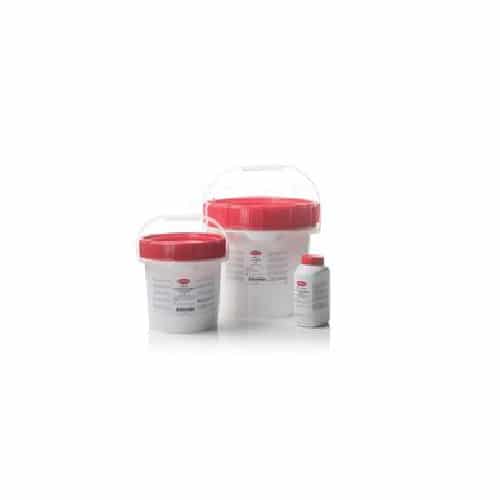
Brain Heart Infusion Agar 500g
Login to see pricesBrand:
Thermo ScientificTM OxoidTM
Cultivate fastidious organisms with highly nutritious Thermo Scientific™ Oxoid™ Brain Heart Infusion Agar (Dehydrated). Brain Heart Infusion Agar is recommended for the cultivation of Streptococci, Neisseria and other fastidious organisms.
Brain Heart Infusion Agar, Oxoid Composition
| Formula |
gm/litre |
| Brain infusion solids |
12.5 |
| Beef heart infusion solids |
5.0 |
| Proteose peptone |
10.0 |
| Sodium chloride |
5.0 |
| Glucose |
2.0 |
| Disodium phosphate |
2.5 |
| Agar |
10.0 |
| pH 7.4 ± 0.2 @ 25°C |
Brain Heart Infusion Agar, Oxoid Preparation:
Suspend 47g in 1 litre of distilled water. Bring to the boil to dissolve completely. Sterilize by autoclaving at 121°C for 15 minutes. Mix well and pour into sterile Petri dishes. For blood agar, cool to 50°C and enrich with 10% v/v sterile defibrinated blood.
Storage conditions and Shelf life
Store the dehydrated medium at 10-30°C and use before the expiry date on the label.
Store the prepared plates of medium at 2-8°C.
Precautions
The medium is tested for compatibility using 7% v/v oxalated horse blood, defibrinated horse blood or defibrinated sheep blood. There should be no evidence of lysis or darkening after incubation at 37°C, 25°C or 4°C for 72 hours.
When using this medium to isolate Histoplasma capsulatum, Coccidioides immitis or other pathogenic fungi which can produce free infective spores, extreme care must be taken to avoid dissemination of infective particles in the laboratory. The cultures should be examined only in a closed, filtered air cabinet.
This medium is unsuitable for the screening of vancomycin resistant enterococci (VRE). More suitable and superior media for the screening of VRE are available; Brilliance VRE PO1226A or Remel BHI with Vancomycin RO1176.
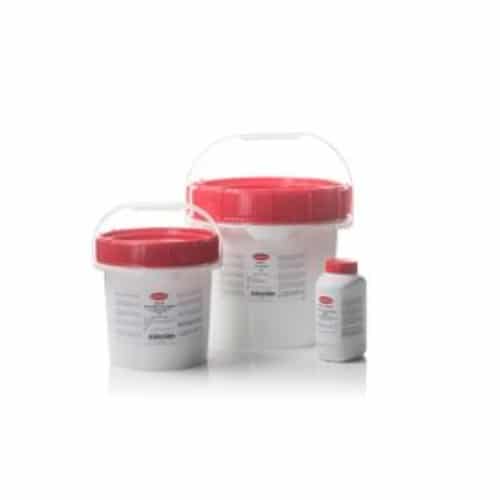
Brain Heart Infusion Broth 500g
Login to see pricesBrand:
Thermo ScientificTM OxoidTM
Cultivate streptococci, Neisseria and other fastidious organisms with Thermo Scientific™ Oxoid™ Brain Infusion Broth (Dehydrated). The medium is highly nutritious and well buffered to support the growth of wide variety of organisms. It is recommended for blood culture work for the isolation and cultivation of pathogenic fungi.
Brain Infusion Broth, Oxoid Composition
| Formula |
gm/litre |
| Brain infusion solids |
12.5 |
| Beef heart infusion solids |
5.0 |
| Proteose peptone |
10.0 |
| Glucose |
2.0 |
| Sodium chloride |
5.0 |
| Disodium phosphate |
2.5 |
| pH 7.4 ± 0.2 @ 25°C |
Brain Infusion Broth, Oxoid Preparation:
Dissolve 37g in 1 litre of distilled water. Mix well and distribute into final containers. Sterilize by autoclaving at 121°C for 15 minutes.
Storage conditions and Shelf life
Store the dehydrated medium at 10-30°C and use before the expiry date on the label.
Store tubed or bottled medium in the dark and below 20°C.
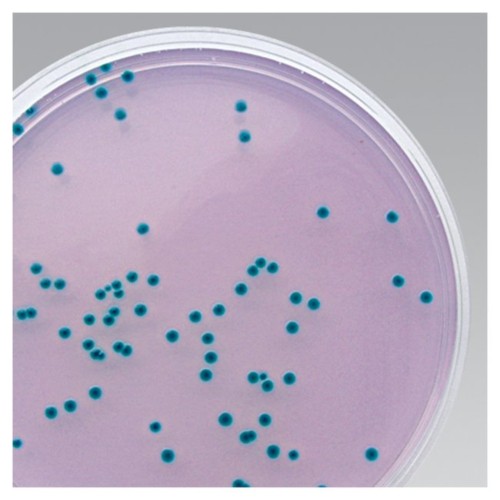
E.Sak Isolation Agar Base 500g
Login to see pricesBrand:
Thermo ScientificTM OxoidTM
Oxoid Cronobacter Sakazakii Isolation Agar (ISO) is a chromogenic medium for enrichment and isolation of Cronobacter spp. from milk and milk products in compliance with ISO/TS 22964: 2006.
E.Sak Isolation Agar Base, Oxoid Composition
| Typical Formula* |
gm/litre |
| Pancreatic digest of casein† |
7.0 |
| Yeast extract |
3.0 |
| Sodium chloride |
5.0 |
| Sodium deoxycholate†† |
0.6 |
| 5-Bromo-4-chloro-3-indolyl α-D-glucopyranoside |
0.15 |
| Crystal violet |
0.002 |
| Agar |
12.0 |
| pH 7.0 ± 0.2 @ 25°C |
E.Sak Isolation Agar, Oxoid Preparation:
Suspend 27.75g in 1 litre of distilled water. Bring to the boil to dissolve completely. Sterilize by autoclaving at 121°C for 15 minutes. Cool to approximately 50°C. Mix well and pour into sterile Petri dishes.
Storage conditions and Shelf life
Store the dehydrated medium at 10-30°C and use before the expiry date on the label.
The prepared medium is best used freshly prepared, but may be suitable for longer storage following in-house validation.

Modified Lauryl Sulphate Tryptose Broth
Login to see pricesBrand:
Thermo ScientificTM OxoidTM
Selectively enrich Cronobacter spp. from milk and milk samples using Thermo Scientific™ Oxoid™ Modified Lauryl Sulphate Tryptose Broth Base (Dehydrated). Modified Lauryl Sulphate Tryptose Broth Base was originally described by Guillaume-Gentil et al. for the selective enrichment of Cronobacter spp. The high salt concentration of the medium restricts the growth of other members of Enterobacteriaceae and the combination of vancomycin and sodium lauryl sulphate inhibits the growth of Gram-positive organisms commonly isolated in production environments.
Modified Lauryl Sulphate Tryptose Broth Base, Oxoid Composition
| Typical Formula* |
gm/litre |
| Sodium Chloride |
34.0 |
| Enzymatic digest of animal and plant tissue |
20.0 |
| Lactose |
5.0 |
| Potassium dihydrogen phosphate |
2.75 |
| Dipotassium hydrogen phosphate |
2.75 |
| Sodium lauryl sulphate |
0.1 |
| pH 6.8 ± 0.2 @ 25°C |
Modified Lauryl Sulphate Tryptose Broth, Oxoid Preparation:
Dissolve 32.3g in 500ml of distilled water. Sterilize by autoclaving at 121°C for 15 minutes. Cool to approximately 50°C, and aseptically add the contents of 1 vial of Vancomycin Supplement (5mg) (SR0247E) reconstituted as directed. Mix well and aseptically dispense into sterile containers.
Storage conditions and Shelf life
Store the dehydrated medium at 10-30°C and use before the expiry date on the label
Where possible the complete medium should be prepared on the day of testing and stored for no longer than 1 day at 0-5ºC
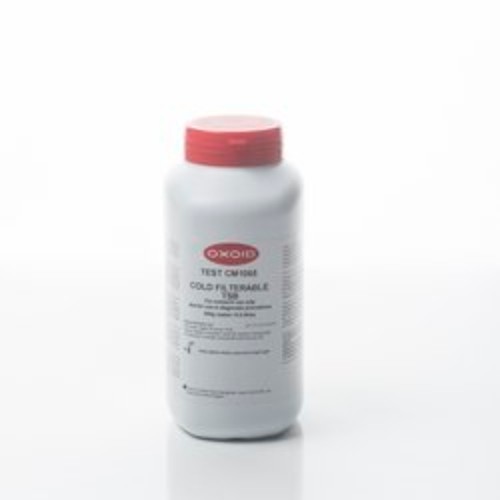
Baird-Parker Agar (ISO) 500g
Login to see pricesBrand:
Thermo ScientificTM OxoidTM
Isolate, enumerate, and identify coagulase positive Staphylococcus aureus in food samples with selective Thermo Scientific™ Oxoid™ Baird Parker Agar (ISO) Base (Dehydrated) while adhering to ISO 6888-1:1999.
Baird Parker Agar (ISO) Base, Oxoid Composition
| Typical Formula* | gm / litre |
| Pancreatic digest of casein | 10.0 |
| Meat extract | 5.0 |
| Yeast extract | 1.0 |
| Sodium pyruvate | 10.0 |
| L-glycine | 12.0 |
| Lithium chloride | 5.0 |
| Agar | 20.0 |
| pH 7.2 ± 0.2 @ 25°C |
Baird Parker Agar (ISO) Base, Oxoid Preparation:
Suspend 63g of Baird-Parker Agar (ISO) Base in 1,000ml of distilled water. Boil to dissolve the medium and sterilise by autoclaving at 121°C for 15 minutes. Cool to 47°C and aseptically add 50ml of Egg Yolk Tellurite Emulsion (SR0054). Mix well and pour into sterile Petri dishes.
Storage conditions and Shelf life
Store the dehydrated medium at 10-30°C and use before the expiry date on the label.
The prepared medium is best used freshly prepared, but may be suitable for longer storage following in-house validation.
Precautions
Atypical colonies have the same size as typical colonies but can be shining black with or without a narrow white edge; the clear zone or opacity halo can also be absent or barely visible. Grey colonies, free of clear zone, can also be regarded as atypical.
Regard all typical and atypical colonies as coagulase-positive staphylococci irrespective of negative reactions on the medium and carry out further tests.
Colonies of some contaminating organisms growing in close proximity to the coagulase positive colonies may partially digest the coagulase halo reaction.



